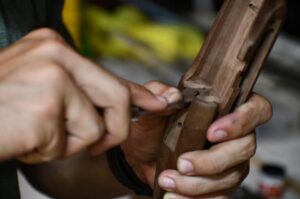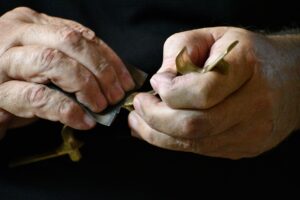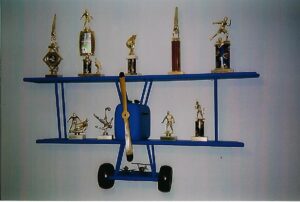Inspiration is a most interesting phenomenon. I have often wondered where it comes from. This story is inspired by several photographs taken by a lovely young woman named Heather. The moment captures me working with my grandson, building a flintlock rifle kit. One photo shows him working on the fitting of the barrel to the stock, while another photo shows me removing the excess casting material from the rifle’s brass parts. His hands are young and strong. My hands are old now, scarred a bit from many years of projects. As I marveled at the contrasting photos, the inspiring moment came when Heather posted those photos on social media along with a simple poem from St. Francis of Assisi. She gets full credit for my inspiration to write this story.
“He who works with his hands is a laborer. He who works with his hands and his head is a craftsman. He who works with his hands and his head and his heart is an artist.”
~ Saint Francis of Assisi
The quote started me thinking about how the process of learning is enhanced by life’s opportune moments. It made me wonder: how did my labors (work ethic) and craftsmanship (skills) evolve into the inspiration to create beautiful things, and whether I really had any artistic creations in my life? While my hands show my years of labor and craftsmanship, did I achieve that third level of becoming an artist that engaged my heart?
As a young boy, I lived in the inner city. There was no yard for me to play in, and my family did not have a lot of money for fancy toys. My “play time” usually took the form of playing with other children’s toys, and my favorite was an Erector Set. I loved to build things with them—not simple things, mind you—but complex things like an electrically operated drawbridge. Give me enough Lincoln Logs, and I could build you a frontier fort. No Lincoln Logs, then give me some clothes pins, and I would layout a ship deck on the floor into which children’s imaginations could step inside and sail the world.
As I grew older, I discovered a hobby shop around the corner from my grandmother’s house. There I found hundreds of stick-built airplanes, boats, wooden cars, and even rocket-powered jet cars. I built them to fly, but I had no room to send them airborne. These were peaceful times for me. I spent a lot of time with my grandmother, learning how to make cheese and sausage. I remember her kitchen well and the many stories she would tell about her life in Lithuania. At thirteen, my family moved away from the city to the rural countryside. It would not take long to adapt my interests to include building stone dams in the creek near me, tree houses, real boats, and wheeled vehicles to race with my friends down the local hills. It would be there, in the cold Ohio winters, that I would discover the “Allied Corporation Catalog “of electrical components. I could buy parts to make radios, both normal and shortwave, just to name a few. A Schwinn bike with a gasoline motor and a Wizzer expanded my world. I could take it apart and put it together without any instructions.
As I approached my teen years, I wanted badly to drive a car. My father, in his wisdom, let me buy a 1948 Crosley Sedan for $50. Today, I would tell him that what he did, in his wisdom, was to keep me home in the garage, learning, working, and rebuilding, until I was 16. Yes, I made the car run. It would be a quick transition to more cars, always in need of repair. I am sure that the arthritis I have in my hands today comes from the years I spent laboring at the heavy work of rebuilding motors, suspensions, and car bodies. My budding career as a mechanical engineer was preparing me for St. Francis’s next step, the transition to a craftsman. That did not happen, however, until after I got married.
My wife and I saved and bought a small house. It needed work—a lot of work. The house needed a new roof, new woodwork, internal doors, a dishwasher, and kitchen cabinets. The walls needed patching, the well pump needed fixing, and the gas clothes dryer we owned needed GAS. Yes, I learned how to trench by hand and install a legally permitted gas line. This last project would be repeated twice in my life. The difference now was that the projects were not only for me but also for my family. I could see that the craftsmanship of my labor would be reclaimed as we sold one home and moved up into larger homes. Repeatedly, my wife and I would pour our labor and craftsmanship into each house. Time and time again, as we sold and repurchased a home, my wife and I would recover real value from our invested efforts. This was the best investment and savings plan you could find in America at the time.
It is probably prudent to pause here for a moment and reflect on how so many diverse skills were accumulated by my wife and me. There was no secret; we took time to learn from those around us who had walked a similar road. For me, it was books, night school, multiple jobs, trying, failing, and trying again that taught me what I needed to know. There was no Internet or YouTube. Craftsmanship is a product of two things: attitude and practice. While my attitude did not want to settle for anything less than perfection, it would be my habits of continually refining skills that would pay off. Mistakes were an excellent teacher too. All this taught me that there is no task that humans cannot accomplish if they seek knowledge and just work hard at it.
To end this simple story, I need to transition to the part of my life when my two grandsons came into this world. I never knew either of my grandfathers, so, I must admit, I had no clue how to include these two beautiful lives in my own life. Learning came quickly. I saw them as my father saw me—young men, hungry for knowledge and skills. They would grow up with me building toys, their bedroom furniture, camping, and fishing. I would spend time showing them how to use tools, labor, and craft just about anything. These times would take me back to those peaceful times I had so many years ago as a child myself.
Now that I am retired from my career, it is no longer just about working hard and doing things correctly. As St. Francis of Assisi said, the goals have now changed for me. When purpose and love are present, so is the heart. What is the difference between a laborer, a craftsman, and an artist? The honest laborer is not to be demeaned. The sweat of labor is a contribution that created our country and sustains our economy. It is the cornerstone upon which great things are built. The craftsman distinguishes themselves by imparting experience and skills to every task. It is the craftsman’s knowledge that builds complex machines, sends men into space, and produces what fills the museums of the next generation. It is the craftsman who teaches others so that life itself can be sustained and improved. But what about the artist? To become an artist, one must freely place their heart into everything they have created. And like our own Creator, they must LOVE their “Creation.” It is the artist who gives each generation the inspiration to labor and craft with all their heart. It will always be the artist who inspires our world to flourish rather than just exist.



